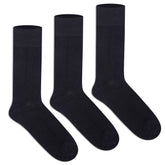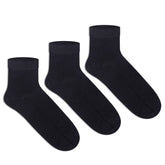Picture this: You're in the 89th minute. Your legs burn. Your feet ache. But your socks? They're still doing their job. That split-second when you need to make that crucial tackle or sprint for the winning goal, your comfort matters more than you think.
I have been around football long enough to know that players obsess over boots, jerseys, and shin pads. But football socks? They're often an afterthought. That's a mistake. The right pair can make the difference between walking off the pitch with a smile or hobbling off with blisters.
Today, we are diving deep into the compression versus regular football socks debate. I will walk you through the manufacturing secrets, the technology that goes into each pair, and help you figure out which type suits your game best.
Understanding Regular Football Socks
What Makes a Regular Football Sock?
Regular football or soccer socks are the workhorses of the sport. They focus on the basics - comfort, durability, and moisture management. These socks typically feature traditional cushioning in key areas like the heel and forefoot. They are designed with standard elastic bands around the arch and cuff.
The beauty of regular football sports socks lies in their simplicity. They use tried-and-tested materials like combed cotton blends or synthetic fibers. The construction focuses on creating a comfortable barrier between your foot and boot without adding unnecessary bulk.
Manufacturing Process Behind Regular Socks
The creation of quality regular football socks starts way before the actual knitting begins. It begins with yarn inspection, a critical step that determines everything from stretch to feel. The best manufacturers source their materials from certified suppliers who meet strict standards for quality and safety.
The knitting process itself is fascinating. Modern factories use machines with needle counts ranging from 96 to 240 needles. Higher needle counts create finer, more comfortable socks. The process involves multiple quality checks; technicians hang sample socks on machines as references, ensuring every pair matches exact specifications for color, size, and design.
What really separates premium manufacturers is their attention to detail. They check machines every four hours. They test length, width, and stretch parameters using specialized equipment. Loose threads get removed manually. The seams undergo analysis for fineness. Any sock that doesn't meet standards gets pulled from the line.
The Science of Compression Football Socks
How Compression Technology Works?
Compression socks work on a simple but powerful principle: graduated pressure. They apply the most pressure at your ankle and gradually decrease it as they move up your leg. This design promotes better blood circulation, which means more oxygen reaching your muscles and faster removal of waste products like lactic acid.
For football players, this translates to reduced muscle fatigue during play and faster recovery afterward. Your legs feel fresher for longer. That burning sensation in your calves? It hits later and less intensely.
The compression also provides muscle support. It reduces vibration in your leg muscles when you run or jump. Less vibration means less micro-damage to muscle fibers, which equals better performance and quicker recovery.
If you’re looking for women’s sports socks with the same feature, do check out our collection today!
Advanced Manufacturing Techniques
Creating compression socks for women and men requires precision that goes beyond regular sock manufacturing. The knitting machines must be programmed to create different tension zones throughout the sock. This demands sophisticated equipment and skilled technicians who understand how compression gradients work.
The seamless toe technology becomes even more crucial in compression socks. Traditional toe seams can create pressure points that become painful under compression. Advanced manufacturers use hand-linking techniques or automatic linking machines to create smooth, seamless toe closures.
Quality testing for compression socks involves additional steps. Manufacturers test compression levels at different points along the sock. They verify that the graduated pressure follows the intended pattern. They check durability under repeated stretching; compression socks need to maintain their compression properties, wash after wash.
Performance Comparison: On-Field Analysis
Comfort and Fit Factors
Comfort starts with construction quality. The seamless toe design prevents hot spots and blisters, crucial when you're wearing boots for 90+ minutes. The best manufacturers achieve this through meticulous hand-linking processes where skilled workers connect the toe area without creating bulk or rough seams.
Regular socks offer straightforward comfort. They focus on cushioning and moisture-wicking without additional pressure. For players who prefer a traditional feel or have circulation sensitivities, regular socks provide reliable performance without compression constraints.
What do compression socks do? - H3
They take comfort in a different direction. Initially, they feel tighter; that's by design. But as you play, many athletes report feeling more supported and stable. The key is proper sizing. Too tight, and they become uncomfortable. Too loose, and you lose the compression benefits.
Durability and Longevity
Manufacturing quality directly impacts how long your socks last. Premium yarn quality inspection ensures consistent fiber strength. Manufacturers who invest in vertical integration, like having in-house elastic yarn covering machines, maintain better quality control throughout the process.
Compression socks face unique durability challenges. The elastic fibers that create compression are under constant stress. Quality manufacturers address this by using superior elastane materials and reinforcing high-stress areas during the knitting process.
Regular socks typically last longer because they don't have the same stress on elastic components. However, the best compression socks, when properly manufactured, can match regular socks for longevity while providing additional performance benefits.
Performance Enhancement Features
The modern football socks are based on the latest technologies, not only on comfort. Antimicrobial therapy avoids the growth of odor-producing bacteria. There are also manufacturers with silver ion technology, which offers long-lasting freshness so that your socks remain fresher longer, even after hard training.
There has been a lot of change in moisture management. High-quality socks contain moisture-wicking fibers that are strategically located in the high-sweat zones. The knitting patterns form channels that take the sweat away from your skin and toward the outer side of the sock, where the sweat can evaporate.
Regulation of temperature is more important than most players can imagine. Good socks are made of breathable material and ventilation zones to prevent overheating while maintaining warmth when needed.
Choosing the Right Sock for Your Needs
1. Player Position Considerations
The nature of your job influences the number of socks you require in a way you would not imagine. Players who perform many sliding tackles require additional strength in the heel and toe regions. The midfielders who have to cover the most ground have the advantage of improved moisture management and comfort facilities.
Socks that slip or bunch up in the boots are not suitable for the forwards who have to change directions quickly. The fit is imperative; even the slightest movement between the sock and the foot will lead to blisters when sprinting.
The goalkeepers also have their own needs. They keep going on and off the ground and exert pressure on other parts of the sock, unlike outfield players.
2. Playing Conditions and Frequency
Weather and playing surface impact sock choice significantly. Wet conditions demand better moisture management. Artificial turf creates more friction, requiring more durable materials.
Training frequency matters. Players training daily need socks that recover quickly, both in terms of shape retention and hygiene. How do compression socks work? They provide recovery benefits between sessions, while high-quality regular socks might be more practical for everyday training wear.
Match day versus training also influences choice. Some players prefer compression socks for matches but regular socks for training. Others stick with one type for consistency.
Manufacturing Quality Indicators
What to Look for in Quality Football Socks?
Quality begins with certifications. Search out manufacturers that have SA8000-approved labor standards and OEKO-TEX-approved textile safety. These are signs of a severe approach to quality and ethical production.
Look at the details of construction. The smooth toe closures are a sign of advanced manufacturing. The high-wear areas are reinforced in the heel and toe. Appropriate arch support bands imply the knowledge of the anatomy of the foot.
The quality of the yarn is enormous. Luxury producers tend to mention where their yarn is sourced and how it is processed. An example is mercerized cotton, which undergoes special processing to produce stronger, smoother, and shinier fibers than ordinary cotton.
Innovation in Football Sock Manufacturing
The sock industry continues evolving. Modern knitting machines with 300+ units in single facilities enable mass production without compromising quality. Computer-controlled knitting allows for complex patterns and compression zones that weren't possible decades ago.
Silver Frost antimicrobial technology represents one innovation that's becoming standard in premium socks. This invisible treatment provides lasting protection against odor-causing bacteria without affecting comfort or breathability.
Future innovations focus on smart textiles that can monitor performance metrics or adjust compression based on activity levels. While still emerging, these technologies show where football sock manufacturing is heading.
The Bottom Line
The decision between compression and regular football socks depends on your needs, preferences, and the way you play. Normal socks are excellent in simple comfort and dependability. They are ideal for players who seek tested performance without any extra functions.
The compression socks excel in the case of players who want to improve their performance and recover. These are best when you play a lot of football, have problems with leg fatigue, or desire to have all the benefits during the match.
Both of them can be outstanding; what matters is manufacturing quality and a good fit. Seek brands that invest in high-quality materials, superior production techniques, and stringent quality assurance.
It is your feet that take you through every match, every training session, every important moment. They are as good as you are at the game. Whether compression or regular, they should be made with the skill and care that you need in your performance.
Feel the difference of high-quality production. Supersox brings more than 20 years of experience together with the latest technology to develop football socks that make you a better player. Discover our selection of compression socks and ankle-length football socks to be worn by serious players.
FAQs
Do compression socks really work for footballers?
Absolutely. Compression football socks from Supersox improve blood circulation, reduce muscle fatigue, and support faster recovery. Many players report feeling fresher during and after the game, thanks to the targeted pressure zones. They’re especially helpful for intense matches and long training sessions.
Can women use compression football socks?
Yes, compression socks aren’t just for men. Supersox offers sports socks for women designed for a secure fit, optimal performance, and compression. They provide the same muscle support and circulation benefits, whether you're playing competitively or training regularly.
How long should I wear them before/after matches?
For best results, wear your Supersox compression socks 30-60 minutes before the game to get the circulation going. After matches, wearing them for 1-2 hours helps reduce soreness and speeds up recovery. Avoid wearing them overnight unless advised by a physician.
Are they worth it for casual players?
Even if you’re not playing professionally, Supersox compression socks can improve comfort and reduce post-game fatigue. They’re great for casual players who want extra support and long-term foot health. Think of it as a small upgrade that makes a big difference.












